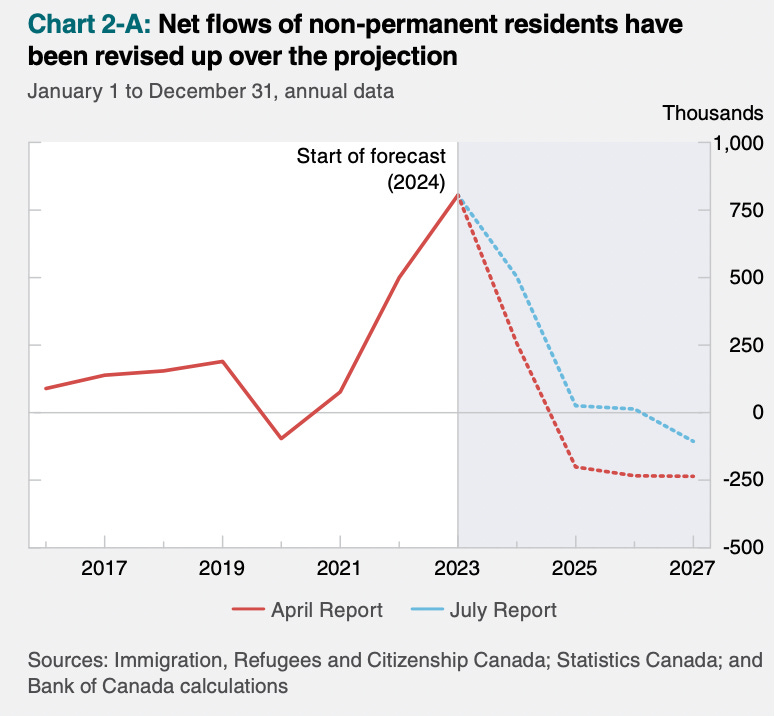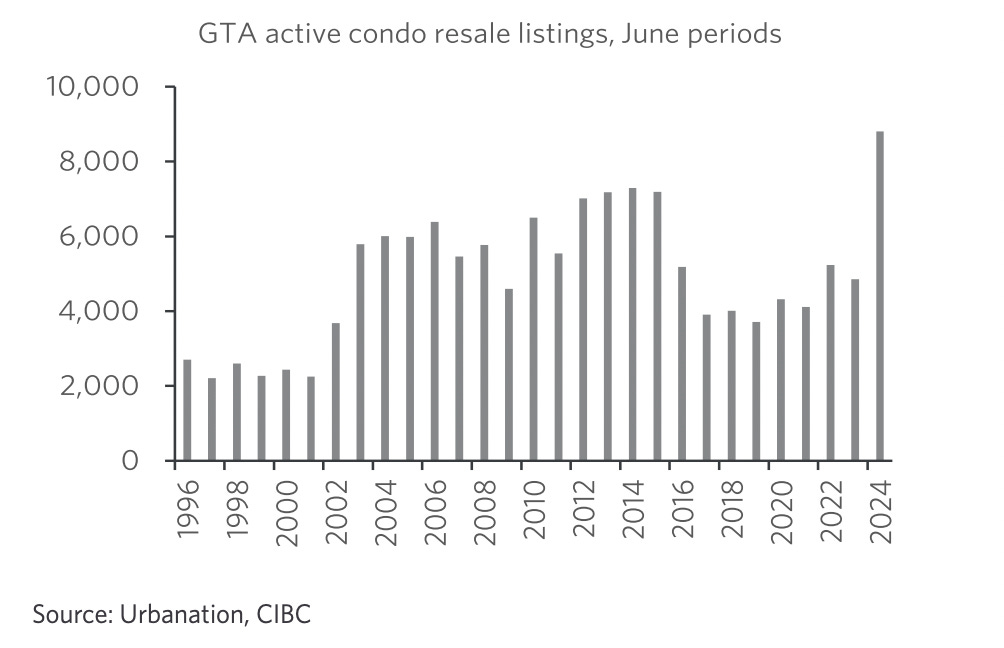Happy Monday Morning!
As expected, the Bank of Canada slashed rates another 25bps this past week. It was a dovish press conference, with Tiff emphasizing excess supply in the economy.
In the words of the BoC, economic growth likely picked up to about 1.5% through the first half of this year. However, with robust population growth of about 3%, the economy’s potential output is still growing faster than GDP, which means excess supply has increased. Household spending, including both consumer purchases and housing, has been weak. There are signs of slack in the labour market. The unemployment rate has risen to 6.4%, with employment continuing to grow more slowly than the labour force and job seekers taking longer to find work.
In other words, we’re adding more people than jobs available, and the economy is already in a per capita recession. Nothing regular readers of this newsletter weren’t already aware of.
Although, the BoC is concerned population growth isn’t slowing as quickly as the feds had promised.
On March 21, 2024, the federal government announced plans to reduce net inflows of NPRs (non permanent residents) to lower their share of the total population from 6.2% to 5% within three years. Overall, this implied that the annual population growth rate would decline by about 2 percentage points in 2025 and 2026. NPRs represented 6.8% of the population at the beginning of April—much higher than at the time of the March announcement—and the share is expected to continue rising over the near term. This suggests that it will take longer for planned policies to reduce NPR inflows to achieve the 5% target.
This is prompting the Bank of Canada to highlight upside risks to shelter inflation. However, as we highlighted last week, we believe those risks are misguided.
In real time, home prices, and rents are flat or declining across the majority of most major metros. Furthermore, mortgage interest costs, which are directly controlled by the BoC have also peaked. We had shelter inflation, the worst in 40 years! But that ship has sailed, and now the hangover is here.
The excess leverage and speculation used to enhance gains on the upside is now sowing the seeds for losses on the downside. There is perhaps no better example of this than in the pre-sale condo space where roughly 70% of all units are sold to investors on spec.
A recent report from CIBC and Urbanation spells out the troubles brewing in the GTA, also known as the pre con capital of Canada. New condo sales have suddenly crashed from record highs to near 30 year lows!
It took 475bps of rate hikes, but the speculative fever the grappled the GTA has been put to bed. Sure rents have risen tremendously on the backs of record immigration, but surging mortgage rates, condo fees, and property taxes have rendered most newly completed condos a financial black hole.
Of all the investors who completed on their condos in 2023 and then rented them out on the MLS, 58% of them took a mortgage and were cash flow negative.
If we focus solely on the levered investors, we see that 77% were cash flow negative in 2023. First half results for 2024 show the situation worsening still, with 82% of leveraged investors in a cash flow negative position.
CIBC’s analysis of the data found that, on average, condo investors that closed on their newly completed units in 2023 experienced negative cash flow to the tune of $597 per month, which was more than 2.5 times greater than the negative cash flow that investors that closed in 2022 experienced (-$223) and a far cry from the days of positive cash flow in 2020-2021. While rents achieved on leases of newly completed condos rose 8% last year to a record high average of nearly $2,700, average monthly ownership costs rose 21% to reach nearly $3,250 per month.
How many of these investors are just barely holding on, waiting for a better time to unload? As it stands right now, active condo listings in the GTA are at record highs!
Yes, the GTA is in a world of its own, but there are similar problems here in Vancouver, just on a much smaller scale.
Shelter inflation? I think not, Mr. Macklem.







Excellent analysis. If you include the present value of future decreased capital appreciation, the net value of condo investment is dire.
Furthermore, this analysis applies to single family homes as well, the numbers are hidden because of the high equity portion of each purchase.
If a company has negative cash flow, this is a huge negative, unless there is an expectation of significant future growth. Condos and homes are no different.
Thanks Steve.
Morning Steve,
Always appreciate your analysis and insights, and almost always find myself in agreement. However in your piece today, I think "shelter inflation" is too narrowly defined. We are just at the beginning of massive upward pressure on the cost of shelter as some 100k households per month renew mortgages now through 2026. Having aligned itself with the federal government from mid-2020 through early 2022 in encouraging Canadians to borrow massively, with an "official promise" of rates remaining lower for longer, the Bank is now facing a catch-22 of its own creation. The lower-for-longer "mis-guidance", combined with other misguided policies (e.g.: the focus on driving the top-line economy through immigration, and over-zealous regulation of residential construction), have resulted in unprecedented upward pressure in the cost of shelter. Annual shelter costs now account for a DOMINANT share of the average household's dispoable income, especially among the front half of the working age population. The Bank's reluctance to reduce the reference rate more quickly is perpetuating the problem. One gets the impression that this reality is in conflict with the Bank's theoretical framework, even as the evidence is abundantly clear, so it is hestiant to do what seems obvious. The BoC is indeed well behind the curve, just as your piece suggests, but it is at least in part because it's conventional inflation-taming tool of higher policy rates is itself causing an ongoing elevated inflation rate due to shelter cost comprising an unconventionally large share of Canadian households' incomes. The only way out of this is of course a dramatic turn-around in the productivity of the overall economy which will remain a pipe-dream as long as Canada's most productive industries are demonized.
Thanks, Gerry